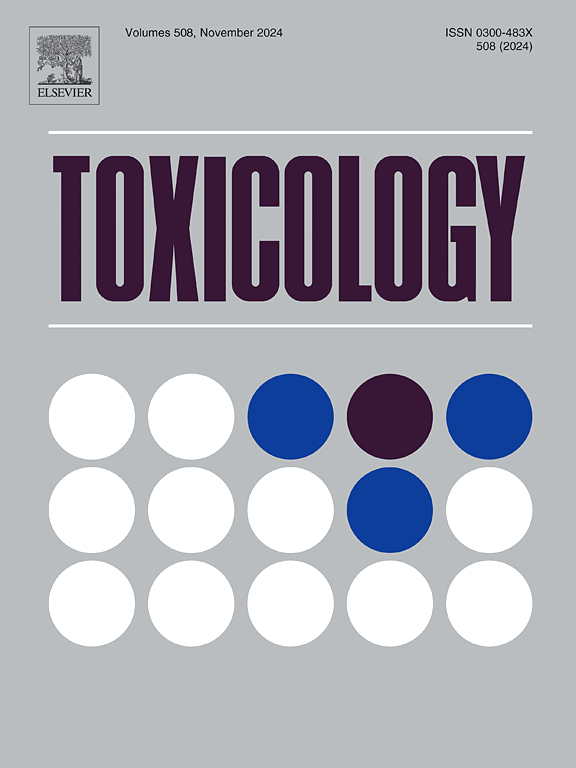Integrated transcriptomic and metabolomic analysis reveals the induction of anoikis in renal proximal tubular epithelial cells by 2,6-Dichloro-1,4-benzoquinone
IF 4.6
3区 医学
Q1 PHARMACOLOGY & PHARMACY
引用次数: 0
Abstract
2,6-dichloro-1,4-benzoquinone (DCBQ) is the most frequently detected and highly toxic halobenzoquinones, a class of aromatic disinfection byproducts (DBPs), yet its renal toxicity and underlying mechanisms largely remain unknown. In this research, we utilized a dual-omics strategy to explore the toxicological impact of DCBQ on human renal proximal tubular epithelial (RPTEC/TERT1) cells. After the cytotoxicity of DCBQ was uncovered by CCK-8 and cell cycle tests, the significantly changed biological events associated with cell adhesion, extracellular matrix (ECM) remodeling, and organelle lumen homeostasis were highlighted as mechanistic cues primarily by integrated transcriptomic and metabolomics analysis. Our subsequent experiments confirmed that DCBQ significantly disrupted mitochondrial membrane potential and led to anoikis, a unique type of programmed cell death distinguished by cell separation from the ECM. Notably, DCBQ exposure significantly suppressed the PI3K/AKT and Ras/ERK signaling pathways, which may have contributed to reduced cell viability, G1 phase cell cycle arrest and induction of anoikis. These results offered new perspectives on the nephrotoxic mechanisms of DCBQ, highlighting its potential to impair cell-ECM interaction and even induce future cancer progression. Our study also proved the benefits of dual-omics application and integrated data analysis for understanding the comprehensive health risks of those poorly-studied emerging contaminants.
综合转录组学和代谢组学分析揭示2,6-二氯-1,4-苯醌在肾近端小管上皮细胞中的诱导作用。
2,6-二氯-1,4-苯醌(DCBQ)是最常检测到的高毒性卤苯醌,是一类芳香消毒副产物(DBPs),但其肾毒性及其潜在机制在很大程度上仍不清楚。在这项研究中,我们利用双组学策略来探索DCBQ对人肾近端小管上皮(RPTEC/TERT1)细胞的毒理学影响。在通过CCK-8和细胞周期测试发现DCBQ的细胞毒性后,主要通过综合转录组学和代谢组学分析强调了与细胞粘附、细胞外基质(ECM)重塑和细胞器腔内稳态相关的显著变化的生物学事件作为机制线索。我们随后的实验证实,DCBQ显著破坏了线粒体膜电位并导致anoikis,这是一种独特的程序性细胞死亡,其特征是细胞与ECM分离。值得注意的是,DCBQ暴露显著抑制PI3K/AKT和Ras/ERK信号通路,这可能导致细胞活力降低、G1期细胞周期阻滞和anoikis的诱导。这些结果为DCBQ的肾毒性机制提供了新的视角,强调了其损害细胞- ecm相互作用甚至诱导未来癌症进展的潜力。我们的研究也证明了双组学应用和综合数据分析对于了解那些研究较少的新兴污染物的综合健康风险的好处。
本文章由计算机程序翻译,如有差异,请以英文原文为准。
求助全文
约1分钟内获得全文
求助全文
来源期刊

Toxicology
医学-毒理学
CiteScore
7.80
自引率
4.40%
发文量
222
审稿时长
23 days
期刊介绍:
Toxicology is an international, peer-reviewed journal that publishes only the highest quality original scientific research and critical reviews describing hypothesis-based investigations into mechanisms of toxicity associated with exposures to xenobiotic chemicals, particularly as it relates to human health. In this respect "mechanisms" is defined on both the macro (e.g. physiological, biological, kinetic, species, sex, etc.) and molecular (genomic, transcriptomic, metabolic, etc.) scale. Emphasis is placed on findings that identify novel hazards and that can be extrapolated to exposures and mechanisms that are relevant to estimating human risk. Toxicology also publishes brief communications, personal commentaries and opinion articles, as well as concise expert reviews on contemporary topics. All research and review articles published in Toxicology are subject to rigorous peer review. Authors are asked to contact the Editor-in-Chief prior to submitting review articles or commentaries for consideration for publication in Toxicology.
 求助内容:
求助内容: 应助结果提醒方式:
应助结果提醒方式:


